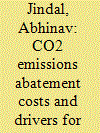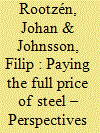|
|
|
Sort Order |
|
|
|
Items / Page
|
|
|
|
|
|
|
| Srl | Item |
| 1 |
ID:
091698


|
|
|
|
|
| Publication |
2009.
|
| Summary/Abstract |
EU Heads of State and Government agreed in March 2007 that the EU will reduce its greenhouse gas emissions to 30% below 1990 levels by 2020 within an international post-2012 climate agreement, provided that other developed (Annex I) countries commit to comparable reductions. Within this context, this paper first explores the pros and cons of many possible conceptual approaches to assess the comparability of the mitigation efforts by Annex I countries. We selected six approaches for further analysis, which represent efforts well and are technically feasible. The implications of each of these six approaches were analysed in terms of the reductions and abatement costs that must be made by different Annex I countries to meet an aggregate reduction of 20% and 30%, respectively, below 1990 levels by 2020. The analysis indicates that significant reductions are necessary for all developed countries. This study shows that reductions by the EU of at least 30%, combined with comparable reduction efforts by other developed countries to meet the aggregate Annex I reduction target of 30% by 2020 and support of developed countries for developing countries to keep their emissions 15-30% below the baseline, are sufficient to achieve the EU climate goal of 2 °C.
|
|
|
|
|
|
|
|
|
|
|
|
|
|
|
|
| 2 |
ID:
126490


|
|
|
|
|
| Publication |
2013.
|
| Summary/Abstract |
One of the actions proposed to reduce greenhouse gas (GHG) emissions in South Africa (SA) is to install carbon capture and storage (CCS) at new energy-producing plants. This paper aims to evaluate the costs and GHG emissions of implementing CCS at a coal-fired integrated gasification combined cycle (IGCC) power plant, at a coal fired ultra-supercritical (USC) power plant, at a synthetic fuel coal-to-liquid (CTL) plant and at a gas-to-liquid (GTL) plant for SA. The approach for comparing of these CCS applications is based on a combination of a techno-economic analysis with a life-cycle assessment. As expected, the generating costs in plants with CCS are higher than without CCS for all case studies. GHG-abatement costs in 2040 are shown to be the lowest for the IGCC power plant at 173 ZAR07/t CO2eq, followed by the USC power plant at 227 ZAR07/t CO2eq. These costs are considerably higher for the CTL and GTL plants. The results show that from an economic perspective, CCS might be an attractive option for CO2 mitigation in SA especially for the electricity sector. However, a prerequisite for the implementation of CCS is that the technology reaches commercial scale for the investigated options and is socially accepted.
|
|
|
|
|
|
|
|
|
|
|
|
|
|
|
|
| 3 |
ID:
096742


|
|
|
|
|
| Publication |
2010.
|
| Summary/Abstract |
In the run-up to the Copenhagen climate summit, the USA announced an emissions reduction target of 17% by 2020 (relative to 2005), and the EU of 20-30% (relative to 1990). For the same time horizon, China offered to reduce the CO2-intensity of its economy by 40-45% (relative to 2005), but rejects a legally binding commitment. We use the targets announced by the EU and the USA to analyze the potential gain for China if it were to adopt a binding emissions target and join an international emissions trading scheme. We show that China would likely benefit from choosing a binding target well below its projected baseline emissions for 2020.
|
|
|
|
|
|
|
|
|
|
|
|
|
|
|
|
| 4 |
ID:
192740


|
|
|
|
|
| Summary/Abstract |
Indian power industry contributes nearly half of its overall CO2 emissions. In this study, we answer three related questions. First, what is the abatement cost of CO2 emissions for the Indian thermal power industry under three different policy scenarios - business as usual, emissions reduction only, and simultaneous emissions reduction and energy efficiency enhancement. Second, what are the determinants of these abatement costs of CO2 emissions. Third, which abatement policy scenario is more beneficial. For this, we employ a plant level dataset covering 93% of installed capacity and use a parametric quadratic directional output distance function to estimate marginal abatement costs by applying deterministic linear programming methods. Our findings are: First, the abatement costs range between US$ 46.43–71.11 per ton CO2, depending on the policy scenario chosen. Second, plant age, location, size, ownership, and CO2 intensity are all significant drivers of abatement costs. Third, while greater emissions reductions are possible under the emissions reduction only scenario vis-à-vis simultaneous emissions reduction and energy efficiency enhancement scenario, both scenarios are compatible with meeting the Paris agreement goals. This paper helps decision makers to allocate CO2 abatement targets to plants in line with their abatement costs and potential.
|
|
|
|
|
|
|
|
|
|
|
|
|
|
|
|
| 5 |
ID:
115669


|
|
|
|
|
| Publication |
2012.
|
| Summary/Abstract |
This paper estimates the potential for energy-related greenhouse gas emission (GHG) reductions in Brazil, their abatement costs and proposes a number of policies to achieve these reductions. The Brazilian energy system is very peculiar as renewable energy accounts for some 45% of total primary energy and 85% of electricity production. The following sectors are covered in this paper: industry, transports and petroleum sector. Compared to a business-as-usual reference scenario, results show a potential to reduce future energy-related GHG emissions by 27% in 2030. However, in spite of that, the mitigation potential identified here is not large enough, in absolute terms, to reduce energy-related GHG emissions below the current level in Brazil by 2030.
|
|
|
|
|
|
|
|
|
|
|
|
|
|
|
|
| 6 |
ID:
110428


|
|
|
|
|
| Publication |
2011.
|
| Summary/Abstract |
This study provides a conceptual framework for exploring the bargaining space within international climate negotiations based on important economic, political and environmental considerations. Based on it, we analyse combinations of the proposed emission reduction ranges for Annex I countries as a group (25-40% below 1990 levels) and non-Annex I as a group (15-30% below baseline) by 2020 to limit global warming to 2 °C. We use results of the FAIR model with costs estimates based on two energy system models. We conclude that the range of targets that comply with a set of criteria for economic, political and environmental considerations is smaller than that by environmental considerations alone. More specifically, we find that according to our criteria, a 30% Annex I reduction target below 1990 levels, combined with a 20% non-Annex I reduction target below baseline emission levels (i.e. 20 to 30% above 2005 levels), is the only combination of targets fulfilling all our criteria for both energy system models. Otherwise, reaching the 2 °C target becomes less likely, technically infeasible, or non-Annex I abatement costs are likely to exceed those of Annex I, a result, which we consider less plausible from a political viewpoint in our conceptual framework.
|
|
|
|
|
|
|
|
|
|
|
|
|
|
|
|
| 7 |
ID:
149897


|
|
|
|
|
| Summary/Abstract |
This study examines the impacts felt downstream of carbon pricing and investments made in CO2 abatement within the steel industry. Using the supply of steel to a passenger car as a case study, the effects of a steel price increase on cost structures and price at each step of the supply chain were assessed. Since the prices of emission allowances under the European Union Emissions Trading System fall well below those required to unlock investments in low-CO2 production processes in the integrated steelmaking industry this paper seeks to pave the way for a discussion on complementary policy options. The results of the analysis suggest that passing on the compliance costs of the steel industry would have only marginal impacts on costs and prices for the end-use sectors (e.g., on the production cost or selling price of the passenger car). Under the assumptions made herein, at a carbon price of 100 €/tCO2, the retail price of a mid-sized European passenger car would have to be increased by approximately 100–125 €/car (<0.5%) to cover the projected increases in steel production costs.
|
|
|
|
|
|
|
|
|
|
|
|
|
|
|
|
|
|
|
|
|